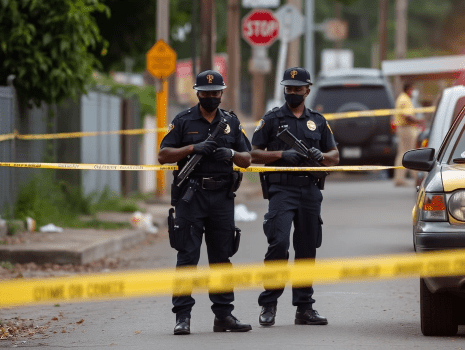St. Thomas Ganja Bust Tells a Bigger Story

It was a quiet Sunday in Prospect, St Thomas. The kind of place where most people were either at church, at the beach, or frying some fish while listening to the sweet hum of a distant sound system. But not at this particular address. No sah. This particular address, by the time the clock ticked 2 am, was hosting an entirely different type of fellowship…the high-stakes, sea breeze version of a cartel clearance sale.
Over 4,000 pounds of compressed ganja, valued at over $12 million, were stashed away in what can only be described as the most productive abandoned building in the Caribbean. Boats lined up, drums of gasoline standing like bodyguards, and nearly 750 parcels just sitting there like neatly wrapped birthday presents from Kingston’s favourite uncle: Uncle Herb.
And surprise, surprise, a Bahamian national is allegedly in the mix. Because why not? If Jamaica’s greatest export is culture, ganja is its most… fragrant ambassador.
But let’s be real: this isn’t just another weed bust to laugh and light up over. There’s something deeper here and it’s not just the smell wafting over from the evidence room.
First of all, can we talk about the scale of this operation? You don’t need that much weed unless you’re trying to sedate a small island or trade for something far more dangerous. And according to Acting Senior Superintendent Patrae Rowe, that’s exactly the concern. Ganja, once the darling of roots reggae and ital culture, is now being used as a pawn in the sinister guns-for-drugs trade.
Let that sink in. This isn’t some man trying to cure his glaucoma or start a boutique herbal tea business. This is about violence, instability, and entire communities being held hostage by firepower bought with neatly packed bricks of ganja.
Yet, here’s the uncomfortable irony: Jamaica is simultaneously criminalising, exporting, and capitalising on cannabis depending on who you are, how you dress, and which side of the tourism brochure you fall on.
If you’re poor and from the inner city, you might still get your life turned upside down over a spliff. But if you’re well-connected and wear a lanyard with a logo, you might be touring a licensed facility explaining terpene profiles to foreign investors.
The weed didn’t change. But the laws and the access certainly did.
So, what should we take away from this St Thomas scenario?
· The guns-for-ganja pipeline is real, and it’s not just a rural problem. When high-grade herb becomes currency for firearms, every corner shop, bus stop, and basic school in Jamaica becomes collateral.
· The double standard in ganja justice still stinks. The country needs a coherent, unified approach to cannabis policy. You can’t have a man in Clarendon doing three years for five ounces while a container of “medical grade” weed leaves Montego Bay port smiling like it just won the lottery.
· Community silence helps crime thrive. The police are once again begging citizens to call in tips. And while we understand that snitching has social risks, what’s the greater risk…silence or stray bullets?
And finally, let’s not ignore the poetry of this bust. Boats, fuel drums, a foreigner, and hundreds of bundles of ganja in a sleepy district by the sea. It feels like a scene from a Caribbean thriller. But it’s not fiction. It’s a reminder.
A reminder that in Jamaica, even paradise has pressure points. And sometimes, behind the palm trees and pretty postcards, there’s a whole underground economy trying to keep afloat even if it means trading roots for rifles.
The good news? The system worked that night. Agencies collaborated. Seizures were made. No shootouts. No fatalities. But if we really want to win, we can’t just keep catching boats after they dock. We have to stop the voyage before it even starts.




